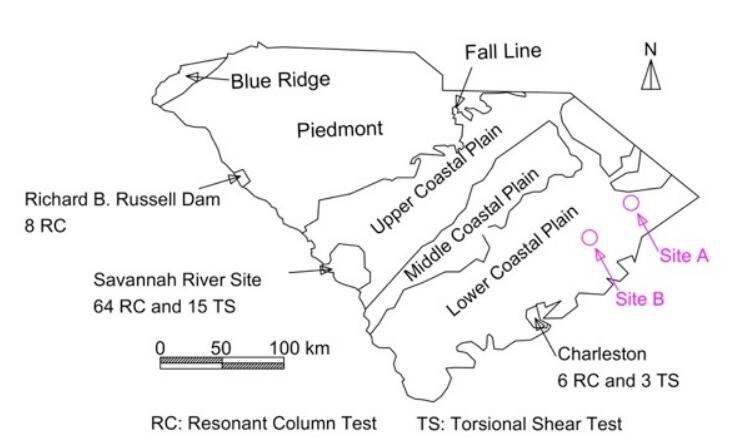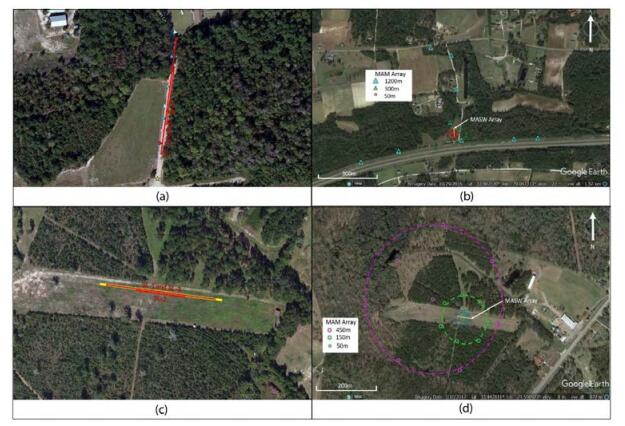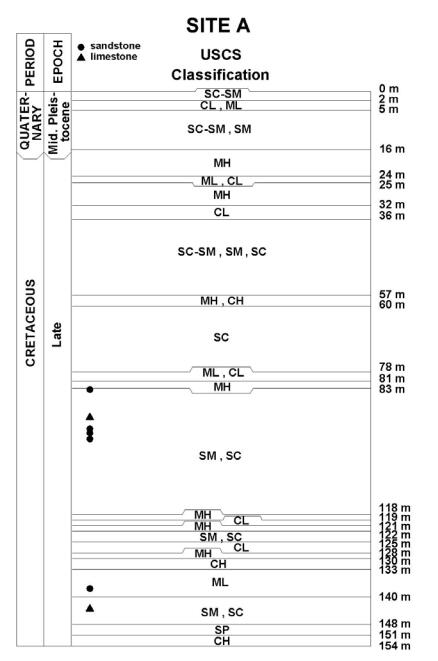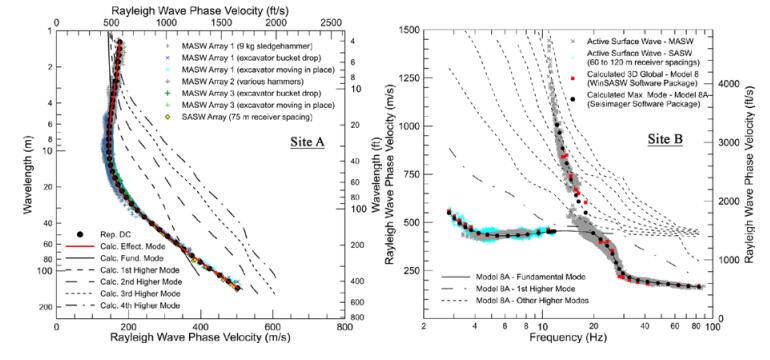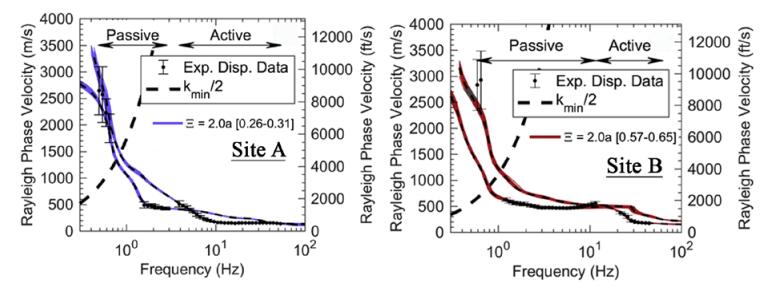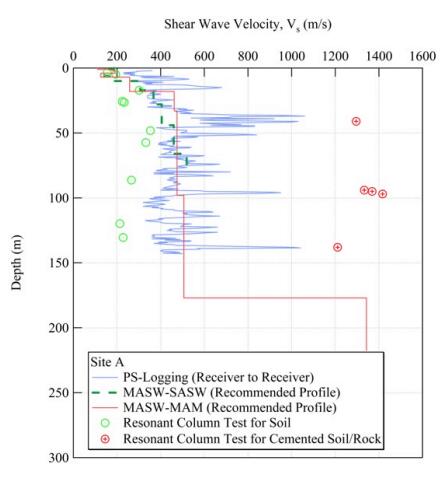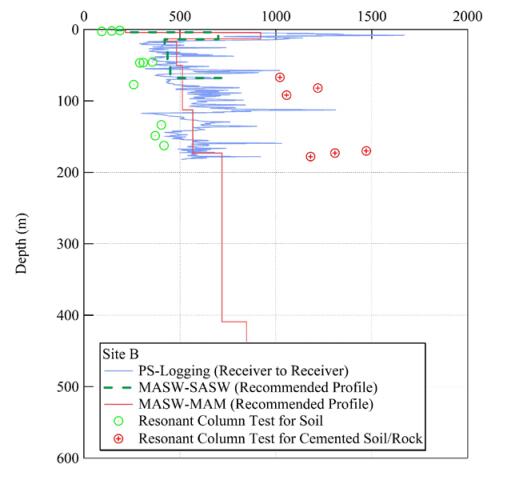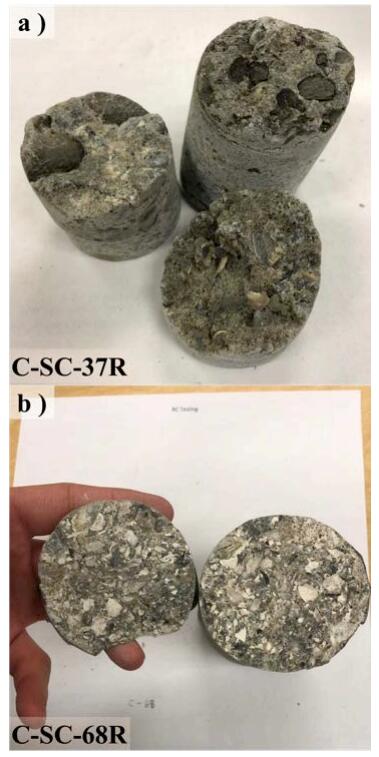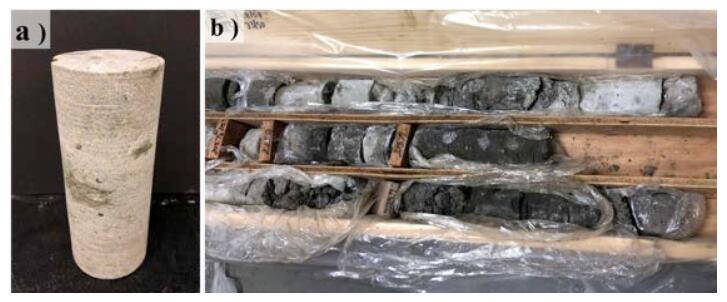The Atlantic Coastal Plain is a geological formation along the east coast of the United States that consists of unconsolidated sediments as thick as 1000 m underlain by very hard rock with shear wave velocity, V s of over 2600 m/s. In South Carolina, this very hard rock layer is located close to or at the ground surface in the central part of the state, and increases in depth towards the coast, and from north to south. The deep sediments are mostly Cretaceous and younger in age and consist of unlithified sediments with weakly lithified units. The deep sediments are unique geological and geotechnical conditions that pose significant challenges to seismic hazard analyses. Having an accurate V s profile for the deep sediment is critical for predicting the level of ground shaking at a particular site. Geotechnical borings were drilled at two locations to depths of approximately 150 m and 190 m for borehole geophysical testing, undisturbed sampling, and soil/rock coring. Geophysical testing was conducted independently by groups of experts at both locations and included P-S suspension logging, a combined multi-channel and spectral analysis of surface waves, and a combined multi-channel analysis of surface waves and microtremor array measurement methods. This paper presents a comparison between field testing results from the different methods and visual classification of soil and rock samples to evaluate uncertainties of deep soil profiles obtained by different methods. In addition, soil samples collected at both sites were tested using the resonant column method to evaluate dynamic properties. The shear wave velocities measured in the lab for soil and rock samples were compared with results from the field measurements. Cementation was found to be one of the important factors affecting the shear wave velocity measurements.
1.
Introduction
Field reconnaissance and subsurface exploration are critical for a geotechnical engineer to accurately evaluate subsurface conditions, perform engineering characterization of soil and rock properties, and foundation design. There are several guidelines and recommendations for geotechnical field investigation [1,2], however there is no clear consensus on the criteria to determine the number, spacing, and depth of soil borings for a project as it depends on local site conditions, type of foundation design, and other considerations for the scope of site characterization. Field investigation programs typically include soil boring and logging, in situ testing, sampling, and non-intrusive testing.
When a seismic design for an earthquake-prone area is required, dynamic soil properties including shear wave velocity, shear modulus, and damping are needed. According to the United States Geological Survey (USGS) 2014 seismic hazard map shown in Figure 1, high seismic hazard areas are located mostly in the Western United States with the exception of a few areas located in the Midwest and Southeastern United States. To perform seismic hazard analyses, a shear wave velocity (Vs) profile of soil sediment to the top of "competent" rock (a boundary defined as having a Vs of 700 m/s) is recommended [3]. In the Western United States where most of the current seismic design criteria have been developed, the top of the competent rock is relatively shallow; hence the required Vs profile is typically no more than 30 m deep. In the Midwest and Southeastern United States, the depth to the top of rock can be much deeper than 30 m. The sediment between the ground surface and the top of competent rock typically consists of old deposits composed of complex layers of soil and rock at different stages of the chemical weathering process. This poses an engineering design challenge for geotechnical engineers because site investigation can be costly and there is a high level of uncertainty in soil and rock characterization of a deep soil profile. Several geophysical methods including borehole and surface geophysical testing can be performed to obtain the Vs profiles but a comparison of results between these methods are rarely performed particularly for very deep soil profiles.
This paper presents a unique set of field and laboratory testing results of deep soil sediments for two sites in the state of South Carolina (see Figure 2). Site A is located in the town of Aynor in Horry County. Site B is located in the town of Andrews in Williamsburg County. The sites are located in the Lower Coastal Plain; a region that is within one of the highest seismic hazard areas in the Southeastern United States (see Figure 1). These sites were chosen because deep soil borings have not been performed in these areas and the Vs profiles and dynamic soil properties are unknown. To obtain the Vs profiles and define the depth to the top of rock, several geophysical testing methods were used: P-S suspension logging, a combined multi-channel (MASW) and spectral analysis of surface waves (SASW) methods (the so-called MASW-SASW method), and a combined MASW and microtremor array measurement (MAM) methods (the so-called MASW-MAM method). Those tests were performed independently by groups of experts in the field. Soil and rock samples were also collected and tested in the laboratory for classification and to obtain the dynamic soil properties. The main objective of this paper is to compare results between field methods and visual classification and geological logging of soil and rock samples to evaluate uncertainties of deep Vs profiles obtained by different methods.
1.1. Background
The subsurface geology of the South Carolina (SC) Coastal Plain consists of ocean-ward thickening Cretaceous (approximately 65 to 135 million years old) and younger sediments underlain by Mesozoic/Paleozoic basement rocks. The thickness of the Coastal Plain sediment along the Atlantic Coast varies from approximately 400 m at Myrtle Beach to more than 1200 m at Hilton Head Island. The vertical stratification overlaying the bedrock consists of unconsolidated Cretaceous, Tertiary, and Quaternary sedimentary deposits. The Quaternary deposit is typically found at near-surface sediments with variation in thickness. The Quaternary deposit consists of beach/barrier island sand, silt, clay, and possible shell fragments and gravel. The Tertiary deposit consists of compacted marine, fossil-rich medium quartz sand and stiff clay and silt with lenses of very fine sand. The Cretaceous deposit consists of calcareous sand, silt, and clay with shells and shell fragments interlayered with terrigenous (non-marine) sediments [5].
Andrus et al. [6] compiled Vs profiles obtained from the literature for several locations in SC. These profiles were measured by different borehole and non-intrusive geophysical methods including seismic cone penetration, seismic downhole, suspension logging, and SASW. Ranges of shear velocity were correlated with geological units. An average Vs of approximately 190 m/s was recommended for the Quaternary deposit, and 400–640 m/s was recommended for the Tertiary deposit. The top of rock (i.e., B-C boundary) was defined where the Vs was greater than 700 m/s for the Tertiary and older deposits. The Vs data for the Cretaceous deposit was very limited and typically assumed to be higher than 700 m/s. Representative Vs profiles suggested by Andrus et al. [6] for the Charleston-Savannah and Myrtle Beach areas are shown in Figure 3. They were developed by averaging several Vs profiles obtained primarily for depths no deeper than 30 m. Available Vs data below the depth of 30 m were limited to only a few locations. Therefore, additional Vs data at deeper depths are needed for the South Carolina Coastal Plain in order to reduce uncertainties in estimating Vs for different soil types and geological formations as well as the estimated depth to the top of competent rock.
In addition to the Vs profiles, the variation of shear modulus and damping with shearing strain are important inputs for site response analysis. Zhang et al. [7,8] developed predictive equations for estimating the normalized shear modulus (G/Gmax) and damping (ξ) for South Carolina soils based on geologic age, confining pressure, and soil plasticity. Results were compiled from resonant column and torsional shear tests from 122 soil specimens, 78 of which were from three locations in South Carolina (see Figure 3). Zhang et al. [7] indicated that the geologic age and confining pressure have a larger impact on dynamic properties than soil plasticity. They also reported that Quaternary-age soil dynamic behavior is more linear implying that degradation of the shear modulus and an increase in damping start at higher strain than Tertiary-age soil and residual/saprolite soil. The Zhang et al. [7,8] approach is useful for an estimation of G/Gmax and ξ variation over a range of strain when laboratory testing is not possible. However, more data are needed for strata beneath 30 m and the Cretaceous-age soil.
2.
Methodology
This section presents a brief summary of field and laboratory testing methods. These tests were performed by several groups of experts [9,10,11,12] and data was obtained for comparison purposes. Detailed data analysis of each method is not included in this paper but can be found in Sasanakul and Gassman [13].
2.1. Borehole geotechnical investigation
The geotechnical borings were drilled using a combination of mud-rotary drilling (in general accordance with ASTM D5783) and wireline coring procedures (in general accordance with ASTM D2113). Each borehole was approximately 15 cm in diameter to allow for insertion of the geophysical testing equipment. Split-barrel (split-spoon) sampling and/or thin-walled (Shelby) tube sampling was performed continuously from the ground surface until hard materials were consistently encountered. In split-barrel sampling, a standard 5 cm diameter split steel tube was driven into undisturbed soil at a select depth using a 63.5 kg hammer falling a distance of 76 cm and "continuous" 60 cm interval sampling was performed. Field logging was performed in general accordance with ASTM D5434. As the split-barrel samples were collected, visual classification of the soil was performed in general accordance with ASTM D2488 and the samples were then sealed in plastic bags. Shelby-tube sampling was performed in general accordance with ASTM D1587/D1587M. Several Shelby-tube samples were collected from both sites. In cases where damage to the Shelby-tube sample was considered likely, a pitcher-barrel sampler was used to attempt the sample. A pitcher-barrel sampler consisted of a spring-mounted, 76 cm long, thin-walled tube inner barrel with a rotating exterior cutting shoe/barrel. In softer materials, the spring extended the tip of the thin-walled tube beyond the cutting shoe while in stiffer materials; the spring was compressed resulting in the cutting shoe leading the thin-walled tube. The recovered tube samples were cleaned at each end, and then sealed with wax in general accordance with ASTM D4220/D4220M.
Once hard material was consistently encountered, the mud-rotary tooling was replaced with H-sized soil/rock coring tools. Coring was accomplished by advancing an outer steel casing with rock carbide or diamond bit and an inner sample barrel that is locked into the drill string annulus. A triple-tube, split inner barrel wireline coring system was used in an effort to enhance core recovery. Once implemented, continuous core runs were conducted at 1.5 m intervals. The core samples were collected and visually classified in general accordance with ASTM D2488. The samples were then wrapped in cellophane and placed in polyurethane lined wooden boxes, which were then labeled and prepared for transportation. This procedure was continued until the borehole termination depth was reached. At the termination depth, the borehole was flushed until the geophysical testing was ready to begin logging at which point the drillers removed tooling and P-S suspension logging commenced.
2.2. P-S suspension logging method
In this study, the seismic wave velocities (P- and S- waves) were measured using the OYO P-S suspension logging system. Development of the system can be found in Ohya [14], Nigbor [15], and Diehl et al [16,17]. Overall, the method is performed by lowering the suspension system probe into an uncased or cased fluid-filled borehole. The probe is approximately 7.6 m long and includes a combined reversible polarity solenoid horizontal shear-wave source and compressional-wave source which is paired with two biaxial receivers and separated by a flexible isolation cylinder. The receiver pair is centered approximately 3.8 m above the bottom end of the probe and the receivers are located 1 m apart. The probe is suspended by an armored, multi-conductor cable that is wound about the drum of a winch. The winch is used to meter the cable travel as the probe is lowered into the fluid-filled borehole. The probe is then lowered in increments of 0.5 m and the source is triggered.
When the source is triggered, a pressure wave propagates outward, horizontally into the fluid surrounding the probe. When the pressure wave impacts the borehole wall, it is converted to compression and shear waves that travel along the length of the borehole wall and convert back to pressure waves near the two biaxial receivers. The system records the time it takes for the compression and shear wave impulses to reach the two receivers. The compression and shear wave data are then separated using different filtering techniques, such as adjusting the filter frequency and applying Digital Fast Fourier Transform—Inverse Fast Fourier Transform low-pass filtering. The compression and shear wave velocities are calculated from the distance and time of travel for each waveform from source to receiver 1 and from receiver 1 to receiver 2. These velocities are plotted against the depth of each testing interval. Additional information can be found in GeoVision [10].
2.3. Surface geophysical methods
Two types of surface geophysical methods were employed in this study. These are 1) a combined multi-channel analysis and spectral analysis of surface waves (MASW-SASW) and 2) a combined MASW and microtremor array measurement (MASW-MAM) methods; both are considered non-destructive and non-invasive methods of testing. The testing arrays for each site are shown in Figure 4. The MASW-SASW method is used to characterize the shear wave velocities for the shallow soil strata in the vicinity of the testing site, while the MASW-MAM method can provide the shear wave velocities for the deeper depths.
2.4. MASW-SASW method
Both MASW and SASW methods were performed utilize a series of receivers in linear arrays all recording data simultaneously during dynamic loading at the surface. The MASW method collects multi-channel seismic data while the SASW method collects surface wave phase data traveling from the source to each receiver. Both methods generate dispersion curves and data modeling is performed to obtain the Vs profile [18,19,20,21,22]. Multiple linear arrays incorporating different receiver spacing and locations are used to analyze surface waves of differing wavelengths and frequencies. The Rayleigh and Love waves generated by the sources travel at similar speeds to shear waves and can therefore be used to estimate a representative shear wave velocity for individual layers of soil or rock. Rayleigh waves are measured using a vertical source and an array of vertical receivers and are representative of vertically polarized shear waves as they travel through a layered medium. Love waves are measured using a horizontal source and an array of horizontal receivers oriented perpendicular to the orientation of the linear array and are representative of horizontally polarized shear wave as they travel through a layered medium. This method depends on the dispersive nature of the Rayleigh and Love waves traveling along a layered medium, reflecting and refracting off separate layers, creating small differences in the return time for each waveform. Electrical impulses are generated as waves pass each receiver location and are stored for each dynamic load session. Dynamic loads for these techniques typically range from small hammers and sledgehammers to accelerated weight drops and movement of heavy equipment. Resolution of the wave data is heavily dependent on the precision of the array layouts and how well the receivers are coupled to the exposed surface. In this study, a sledgehammer and a Caterpillar 336F excavator were used as the energy source (bucket drop and moving back and forth in place) to extend the depth of investigation to 60 m, or greater. A large number of 1 and 4.5 Hz geophones were used. The MASW data were acquired along three collocated arrays. Two arrays used 48 vertical 4.5 Hz geophones spaced 1.5 and 3 m apart, respectively and one array used 9 vertical 1 Hz geophones with variable spacing. The length of arrays varied for both sites from 70 to 150 m. Depending on the site, type of energy source, and geophone arrays, the source-receiver offset ranged from 1.5 to 90 m from the end of geophone array and at the center of the array when possible. The SASW data were acquired along a single array at each site. For SASW, the 1 Hz vertical geophones were used with several receiver spacings ranging from 45 to 120 m. The excavator was used as the energy source with the source-receiver offset ranged from 20 to 80 m from the end of geophone array.
The SASW dispersion curves were generated using the software WinSASW V3 and combined with the MASW dispersion curves generated using the software Seismic Pro Surface V8.0 for both sites. The representative Rayleigh wave dispersion curve was modeled using forward and/or inverse modeling in the software Seisimager to develop several Vs models corresponding to different receiver spacing. During this process an initial velocity model generated based on soil boring logs and the iterative process of forward or inverse modeling is performed until a Vs model with low root mean square error (RMS) between the theoretical and experimental dispersion data was developed. More detailed information can be found in GeoVision [11].
2.5. MASW-MAM method
In this study, the MASW method was performed using the same procedure as the combined MASW-SASW but only different arrays of geophones and a sledgehammer was used as the source with the source-receiver offset ranged from 5 to 20 m from the end of geophone array. Unlike the MASW and SASW methods which use an active energy source, the microtremer or MAM method uses passive ambient noise (e.g. traffic, construction, etc) as the source [23]. This method has been used for evaluating the Vs profiles in several research studies [24,25,26,27,28,29]. In this study, the MAM method was performed across large areas surrounding the MASW arrays conducted at each site. Three-component broadband seismometers were used to record ambient vibrations Seismometers were oriented to magnetic north and were buried to provide adequate coupling with the ground surface and to mitigate the effects of wind vibrations. MAM testing at Site A was performed using two roughly-triangular arrays and one circular array as shown in Figure 4b. Each array setup consisted of two quasi-triangular outer-arrays surrounding a circular inner-array, for a total of three arrays, incorporating ten three-component seismometers each with maximum array spacing of 50,300, and 1200 m. MAM testing at Site B was performed using three nested circular arrays as shown in Figure 4d. The arrays consisted of three nested circular arrays incorporating ten seismometers in the 50 m and 150 m array and eight seismometers in the 450 m array.
All of the data recorded at each seismometer station in MAM arrays were computed to generate the representative horizontal to vertical (H/V) spectral ratios curves for both sites. The inversion process was performed using a multi-mode approach by matching various combinations of fundamental, first higher, second higher, and other Rayleigh and Love modes to the experimental dispersion data. The inversion was performed using the Software Geopsy by applying the neighborhood algorithm to locate earth models within a pre-defined parameterization that yield the lowest possible misfit values between the theoretical and experimental data. In this study, about 500,000 to 750,000 trial layer earth models for each distinct parameterization was used to obtain a large number of acceptable models controlled by the experimental data and model parameterization. The inverse problem involved in obtaining a realistic layered earth model from surface wave dispersion data is inherently ill-posed, nonlinear and mix-determined, without a unique solution [30]. This process resulted in over 100 Vs profiles associated with theoretical dispersion curves from each acceptable inversion parameterization obtained from soil boring logs for both sites. In this study, the median Vs profiles was obtained and recommended for each site. More detailed information can be found in Cox and Vantassel [12].
2.6. Laboratory methods
Following completion of the field sample collection, selected core samples were carefully wrapped to preserve the moisture content and stored for laboratory testing. Great care was taken to minimize disturbance to the samples. The soils obtained from the split spoon samplers were classified in general accordance with ASTM D3282 and ASTM D2487. The soil and rock obtained from the Shelby tube and core samplers were tested for the dynamic soil properties using resonant column method according to ASTM D4015. In this study, a Stokoe-type resonant column and torsional shear (RC/TS) apparatus at the University of South Carolina was used. The equipment is fixed-free type, where the soil specimen is fixed in place at the bottom and the driving force is applied at the top. The general principle employed in the RC test is to excite the soil specimen with a steady-state torsional motion over a range of frequencies to identify the first mode resonant frequency. The shear modulus can then be evaluated utilizing the well-defined boundary conditions and the specimen geometry and mass. Material damping is determined by the half power bandwidth or free vibration decay method. The drive system and equipment damping for this apparatus were calibrated according to Sasanakul and Bay [31,32].
3.
Results and discussion
3.1. General description of geotechnical borehole drilling and soil profile
Results from geotechnical and geological logging are presented in Figures 5 and 6 for Site A and Site B, respectively. Soil profiles to a depth of 154 m for Site A and 188 m for Site B were characterized using compiled data from a total of 5 boreholes: 3 boreholes for Site A, and 2 boreholes for Site B. Over 200 samples were tested in the laboratory to classify the soils according to the USCS. Geological logging was carefully performed on core samples to assess geologic age and geological formations native to South Carolina.
As shown in Figure 5, Site A consists of soil deposits from Quaternary and Cretaceous periods. Younger material from Quaternary deposits, located at the top 16 m, consists of silty and clayey sands interbedded with a relatively thin layer of low plasticity clay and silt. Cretaceous deposits are composed of a variety of materials with clayey sand and silt layers appearing to be dominant. These layers are interbedded with layers of low to high plasticity clay and silt with thicknesses ranging from 3 to 5 m. Relatively thin rock layers consisting mainly of sandstone or calcareous sand with thicknesses of less than 1 m were intermittently observed within these layers. Approximately 5–8 m thick sandstone and limestone layers interbedded with thin clayey sand layers were found at a depth between 92–105 m and additional sandstone/limestone layers at a depth of 137–140 m. The presence of thick sand layers, particularly at deeper depths introduced drilling difficulties—a significant amount of borehole fluid circulation was lost—when advancing below 154 m. As a result, the borehole became unstable and had to be terminated at a depth of 154 m, shallower than planned. Due to the instability of the deeper portion of the borehole, the P-S logging was only performed to a depth of 91 m for this borehole. Two additional boreholes were drilled at this site. The second borehole was successfully drilled to same depth as the first borehole and additional P-S logging was performed between the depths of 91–143 m. The P-S logging data of the second borehole was analyzed and combined with the data from the first borehole. Lastly, the third borehole was drilled to a depth of 30 m to allow collection of additional Shelby-tube samples.
Two boreholes were drilled at site B. The first borehole was drilled to a depth of 188 m as planned. The P-S logging was performed at this borehole to a depth of 182 m. The second borehole was drilled to a depth of 46 m and data from the first borehole was used to select soil zones for Shelby tube sample collection. As shown in Figure 6, this site consists of Quaternary, Tertiary and Cretaceous periods. The soil layers directly below the limestone/sandstone at 13–80 m are mainly sandy soils with weakly to strongly cementation. Two additional layers of limestone/sandstone at a depth of 35 and 60 m were observed in the Tertiary deposit interbedded with layers of low and high plastic clayey and silty soils. Level of cementation of these materials is highly variable. At a depth of 70 m, the Cretaceous deposit consisting of mostly cemented clayey and silty soils interbedded with layers of sand was observed. The thickest sand layer was greater than 10 m thick and found at a depth below 155 m. Shell fragments were also observed within these sand layers. Based on the results for both sites, bedrock was not encountered at the depths investigated.
3.2. Comparisons of shear wave velocity profiles
The Vs profiles generated from MASW-SASW and MASW-MAM methods are results of the inversion process. As described previously, numerous theoretical Vs models were developed and compared with experimental dispersion curves as shown in Figures 7 and 8. The representative Vs profiles were selected based on the results from statistical analysis (e.g. the lowest RMS value or misfit value for inversion parameterization) and can be found in GeoVision [11] and Cox and Vantassel [12]. The recommended Vs profiles from both surface wave methods are presented in comparison with results from the P-S logging as shown in Figures 9 and 10. The P-S logging was performed from the ground surface to a depth near the bottom of the boreholes. The MASW-SASW method generated Vs profiles down to a depth of approximately 70 m for both sites. The MASW-MAM method generated profiles down to depths of 275 m and 510 m for sites A and B, respectively. Despite some differences, the overall results from the MASW-SASW and the MASW-MAM methods are in agreement and both are fairly close to the average Vs generated by the borehole P-S suspension logging. The P-S logging method measured the Vs profile with a resolution of 0.5 m, therefore soil layers with thickness greater than 0.5 m and the variation of Vs in very stiff and/or cemented soil layers as well as rock layers were captured by the P-S logging method.
3.2.1. Site A
For site A, the Vs profiles consisting of approximately 7–10 different layers were obtained from the MASW-SASW and the combined MASW-MAM methods and the Vs generally increases as the depth increases. For both methods, the Vs ranged from 150–300 m/s for the Quaternary deposit and from 300–500 m/s for the Cretaceous deposit below 16 m. There are some discrepancies between the borehole and surface geophysical methods; however, in general, the Vs for the younger deposits are lower than the older deposits. The lower values of Vs are likely related to the low confinement at the shallow depth.
At the depth between 35–45 m, the Vs ranged from approximately 800 to 1000 m/s and the core samples from these layers are described visually in the geologic log as alternating layers of loose and hard beds caused by carbonate cementation. These materials are calcareous clayey sand with strong reaction with hydrogen chloride (HCl). There is some trace of shell fragments and muscovite throughout the core. The USCS classifications of these materials are SC and SM.
At a depth between 46–90 m, similar calcareous clayey or silty sand was also found but the core samples were relatively loose and more friable. The reaction to HCl was weak to moderate indicating less carbonate cementation. This observation is consistent with the lower Vs values measured for this material, ranging from 400–600 m/s. There are a few thin layers of strong carbonate cemented sand as shown as spikes in the Vs profile within these depths.
At a depth between 91–154 m, two sharp spikes for Vs of 900–1000 m/s at a depth of 96 m and 139 m are consistent with sandstone samples described as shelly sandstone. This material appeared to be phosphatic grains tightly cemented with carbonate and had very strong reaction with HCl. Drilling difficulties were encountered at this depth (91–154 m) and half of the attempts to collect core samples failed. In addition to the shelly sandstone, the collected samples were mostly classified as loose fine to medium sand with small percentage of clay and reaction to HCl was none to weak. These materials were interbedded with a few thin layers of low to high plasticity clay and silt, cemented clay, and sandstone. The Vs values, with the exception of the sandstone layer, are between 320–660 m/s. The lower Vs values are consistent with loose, relatively weak cemented sands and the higher values are consistent with cemented clay. Photographs of calcareous sand or sandstone from Site A are shown in Figure 11. Even though the Vs values for these materials are over 700 m/s, they are only found sporadically throughout the borehole depth. As a result, the top of soft rock layer with consistent Vs of 700 m/s or higher was not reached and is at a deeper depth. The MASW-MAM method suggests that the stiff layer with very high Vs of over 1300 m/s may be located at a depth below 177 m.
3.2.2. Site B
For site B, the MASW-SASW and the MASW- MAM methods provide the Vs profiles of 6–8 layers of soil. The Vs slightly increases as the depth increases except for the layer between 4–13 m. Overall, the Vs profiles from the SASW and MASW-MAM methods are consistent but the MASW-MAM provides slightly higher Vs values. The MASW-MAM method provides the Vs profile down to a depth of 500 m. Similar to results from site A, the Vs profile obtained from the P-S logging method, is more sensitive to layering than the two surface methods. The presence of limestone layers at shallow depths (6–13 m) resulted in a Vs that is much higher than 1000–1600 m/s. Based on the visual classification, the limestone (Figure 12a) is described as shelly limestone (biomicrite) with highly variable carbonate cementation. Some zones are well-indurated and cemented with a fine-grained carbonate cementation, other zones are friable where bivalves fragments occur in a soft micritic (clay-size) matrix. The samples had high moldic porosity with the appearance of a shell hash (coquina) but most of the shells had either been replaced with calcite/micrite, or all of the shells had dissolved leaving a calcite-cemented clay matrix in its place. Even though the Vs values of the limestone layer are relatively high, the recovered core samples were not entirely intact and could not be used for resonant column testing.
Below the limestone layer, layers of sand and calcite-cemented sandstone were observed at depths between 13–80 m. These layers appear to alternate based on the difficulty in recovering core samples and the spikes observed in the Vs profile as shown in Figure 9. The sand is classified as SC. The Vs values for sand are approximately 300–500 m/s while the Vs values for calcite-cemented sandstone are approximately 700–1000 m/s.
At a depth between 80–82 m, calcareous sandstone layers were observed. These layers were underlain by low plasticity clay or sandy clay for depths between 82 to 111 m. These thick clay layers are described as weakly to moderately cemented with carbonation; calcareous, sandy clay (mostly clay) with trace of 1–2 mm shell fragments. This cemented clay had moderate to strong reaction with HCl. The clay layers are interbedded with claystone (see Figure 12b) and sandstone laminae. The Vs values for these layers range between 540–840 m/s.
At a depth between 112–160 m, the deposits are highly variable. A sharp spike was observed at the depth of 112 m in the P-S logging data, showing the Vs value of 1310 m/s. The material observed at this depth is described as calcareous, clayey sand with strong reaction with HCl. Below this layer at a depth of 118 m, the Vs value was significantly lower, with a value of 300 m/s. Vs increased to 760 m/s at the depth of 130 m. The materials observed within these layers are described as laminated calcareous, silty clay (see Figure 12c). The core samples have a "poker-chip" appearance and consist of dense clay interlaminated with 1–2 mm silty lenses. The material is friable (can break with hand) but firm. Below this layer at a depth of 135 m, a layer of calcareous sandy clay with strong cementation was found and associated with a Vs of approximately 900 m/s. Below this layer, the cementation appears to be weaker which is consistent with the lower Vs of 450 m/s 142 to 155 m. Another spike in Vs of over 1000 m/s was observed at the depth of 160 m due to the existence of a sandstone layer.
At a depth between 161–187 m, more calcareous sandy clay or clayey sand layers were found with the Vs ranging between 500–700 m/s. These layers were underlain by approximately 4–5 m thick layers of sandstone (see Figure 12d) consistent with the Vs of 920 m/s. Near the bottom of the borehole, interlaminated/interbedded sand and clay was found. These materials have very little to no reaction with HCl except where shell fragments occur and the Vs is approximately 500–600 m/s. Although the average Vs of 620 m/s between the depth 155 to 181 m, based on the core logs and the Vs profile from the P-S suspension logging data, a consistent layer of rock with Vs over 700 m/s was not reached at the bottom of the borehole (187 m). In comparison, results from the MASW-MAM method suggest that a layer with Vs of 720 m/s begins at a depth of approximately 173 m.
3.3. Laboratory measurements of shear wave velocities
The Vs results obtained from the resonant column tests at in-situ mean confining stress are shown in Figures 6 and 7 along side the Vs data obtained from the three field methods. The results are separated into two groups: soil samples and cemented soil/rock samples. The soil samples were obtained from both the Shelby tubes and the core samplers. These samples were trimmed to 35.6 mm in diameter with a length to diameter ratio of 2:1 prior to testing. The cemented soil/rock samples were obtained using the core sampler with approximate 63.5 mm diameter and were tested without re-coring or trimming but cut in sections having a length to diameter ratio of 2:1. The soil samples represent a wide variety of soil types including silty clay, clayey sand, and high plasticity clay or silt. These samples had relatively weak or no cementation. The cemented soil/rock samples were very hard and had some imperfections as shown in Figures 11 and 12. In some samples, interbedded lenses of clay or silt were present, whereas some samples appeared to be solid hard rock. As shown in Figures 6 and 7, the Vs of the soil samples from the RC tests are lower than the results from the field tests. The main factor is the tested samples were more representative of weakly to uncemented soil whereas the field Vs were representative of the overall cemented soil layer. Other contributing factors include the differences in stress conditions between the laboratory and the field, and sample disturbance. In contrast, the Vs of the cemented soil/rock samples are higher than the results from the field tests. This finding is possibly due to the fact that the solid rock sample was selected and tested without taking in to account the existence of rock fractures and interlayering system that exists in the field. As mentioned, the resolution for the P-S logging method is 0.5 m, thus the measured Vs represents the average value for a 0.5 m soil layer. Based on the observation of many core samples collected from both sites, there is a large variation of material properties within a 0.5 m core length. As an example, a 14 cm long intact rock specimen that was obtained from an 8m long core with many broken smaller pieces is shown in Figure 13. This sample was selected for resonant column testing because it was long enough to meet the length to diameter ratio requirement of 2:1, and as such, the shear wave velocity measured in the laboratory for this specimen represents the hardest material within the length of the core. Cemented sand, clay lens, and weak rock were observed within the smaller pieces of the same core sample. However, these materials were not tested because the samples were broken, and did not meet the length to diameter requirement.
Based on this study, cementation and soil layering have a major impact on the quantitative estimation of shear wave velocity. Evaluation of the cementation effect on dynamic soil behavior requires further study and more soil samples are required to develop a comprehensive assessment. In addition, the impact of soil layering and the contrast in the Vs profile on the overall site response analysis requires further investigation. The borehole P-S suspension-logging method is limited to feasible drilling depths associated with the available drilling equipment, but allow data collection at known depths and through a specific thickness of soil strata. Soil samples can be collected during drilling for testing in the laboratory. Surface geophysical methods are limited to an acceptable resolution depth, which can provide deeper Vs profiling and are generally less expensive than borehole geophysical investigations. However, the acceptable resolution depth for a surface method investigation is heavily dependent on the borehole logging, geological knowledge of the areas, ambient environment, quality of testing equipment, and variability in seismic sources, as well as the skill and experience of the analysts in the field and office. Importantly, surface methods (MASW-SASW and MASW-MAM methods) characterize the average Vs based on wave propagation characteristics through a large volume of soil/rock and the profiles typically consist of a limited number of representative layers. Conversely, the P-S logging method can be used to characterize the average Vs of the localized soil/rock properties within the tested borehole, thus the profiles provide high level of details with a resolution of 0.5 m.
4.
Conclusions
A field and laboratory investigation was conducted to characterize the dynamic soil properties for two sites in the South Carolina Coastal Plain. Two deep boreholes were drilled and different geophysical methods were used to develop shear wave velocity profiles for each site. Soil profiles consist of a variety of soil types with different bedding features including cemented layers and rock layers with widely varied properties. Overall, the P-S suspension logging method was able to capture the layered profile in detail and the results were validated by visual and laboratory testing of soil/rock samples. Results from the MASW-SASW and MASW-MAM methods showed the Vs profile with similar trend to the P-S suspension logging method. The combined MASW-MAM method provided a 200–400 m deeper Vs profile than the MASW-SASW method used in this study. The borehole depth to the top of the competent rock with the Vs of 700 m/s was not reached at either of the sites. The Vs values measured by the RC method for the soil samples are lower than the field Vs possibly due to the effects of cementation of interbedded materials in the field. However the Vs for rock and cemented soil sample is higher due to the effect of scale and resolution. The influence of cementation and the soil layering system require further study, particularly for the impact on site response analysis. Overall, this study provides an important set of data for the seismic design for South Carolina as well as other areas where there are deep soil sediments over rock layers.
Acknowledgments
This research was supported by the South Carolina Department of Transportation (SCDOT) and the United States Federal Highway Administration (FHWA). The contents of this paper do not necessarily reflect the official views of the SCDOT or the FHWA. The authors would like to express their gratitude to Mr. Joe Gellici, South Carolina Geological Survey for providing detailed geological logs, Dr. Brady Cox, The University of Texas at Austin, for conducting the MASW-MAM tests, Mr. Antony Martin and Mr. John Diehl, Geovision, for conducting the SASW tests and the P-S suspensions logging, and Mr. William Camp, S & ME, for managing the drilling, logging, and sampling.
Conflict of interest
All authors declare no conflicts of interest in this paper.










 DownLoad:
DownLoad:

